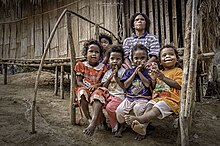セマン族
ネグリトの人々のサブグループ
(セマンから転送)
セマン族(Semang)はマレー半島に住むネグリトの民族である[3][4] 。マレーシアのペラ州、ケダ州、パハン州に居住する[5]。イギリス統治時代は、マレー半島の北に住むオラン・アスリはSakai(サカイ)として分類された[6]。
 セマン族の男性(1906) | |
| 総人口 | |
|---|---|
| c. 4,596 | |
| 居住地域 | |
| マレー半島: | |
| 約 2,000-3,000[1] | |
| 300[2] | |
| 宗教 | |
| アニミズム等 | |
| 関連する民族 | |
| ネグリト, オランアスリ | |
今でも低地のネグリトはSakaiという名でも知られるが、この語はセマンの人々には軽蔑的なものである[7]。彼らは3世紀以前からこの地に住んでいたと記されており、放浪する狩猟採集民として記されている[8]。
部族
編集マレーシア政府によってセマンに分類されるオラン・アスリ部族は以下の通り。
遺伝子
編集セマン族の遺伝子は出アフリカ後に南ルート(イラン→インド→東南アジア)をとったものと、北ルート(イラン→アルタイ山脈→東アジア→東南アジア)をとったものが混在している[10]。例えばジャハイ族では南ルートをとった[11]mtDNAハプログループM21、R21が合わせて83%、北ルートをとった[11]mtDNAハプログループN9aが18%みられる[12]。
脚注
編集- ^ Geoffrey Benjamin & Cynthia Chou (2002). Tribal Communities in the Malay World: Historical, Cultural and Social Perspectives. Institute of Southeast Asian Studies. p. 36. ISBN 98-123-0167-4
- ^ “Kensiu in Thailand”. Joshua Project. 2016年11月10日閲覧。
- ^ “35 Map”. The Andaman Association (18 August 2002). 20 November 2003時点のオリジナルよりアーカイブ。2017年11月23日閲覧。
- ^ “35. The Negrito of Malaysia: Semang”. The Andaman Association (18 August 2002). 25 December 2002時点のオリジナルよりアーカイブ。2017年11月23日閲覧。
- ^ Nik Hassan Shuhaimi Nik Abdul Rahman (1998). The Encyclopedia of Malaysia: Early History, Volume 4. Archipelago Press. ISBN 981-3018-42-9
- ^ Ooi Keat Gin (2009). Historical Dictionary of Malaysia. Scarecrow Press. ISBN 0-8108-6305-7
- ^ Hajek, John (June 1996). “Unraveling Lowland Semang”. Oceanic Linguistics 35 (1): 138–141. doi:10.2307/3623034. JSTOR 3623034.
- ^ Fix, Alan G. (June 1995). “Malayan Paleosociology: Implications for Patterns of Genetic Variation among the Orang Asli”. American Anthropologist. New Series 97 (2): 313–323. doi:10.1525/aa.1995.97.2.02a00090. JSTOR 681964.
- ^ Thonghom (2003年). George Weber: “36. The Negrito of Thailand: The Mani”. The Andaman Association. 20 May 2013時点のオリジナルよりアーカイブ。2017年11月23日閲覧。
- ^ 崎谷満(2011)『ヒト癌ウイルスと日本人のDNA』勉誠出版
- ^ a b 崎谷満(2009)『新 日本人の起源 神話からDNA科学へ』勉誠出版
- ^ Phylogeography and Ethnogenesis of Aboriginal Southeast Asians Catherine Hill Pedro Soares Maru Mormina Vincent Macaulay William Meehan James Blackburn Douglas Clarke Joseph Maripa Raja Patimah Ismail David Bulbeck Stephen Oppenheimer Martin Richards Molecular Biology and Evolution, Volume 23, Issue 12, 1 December 2006, Pages 2480–2491, https://doi.org/10.1093/molbev/msl124
参考
編集Benjamin, Geoffrey. 2013. ‘Why have the Peninsular “Negritos” remained distinct?’ Human Biology 85: 445–484. [ISSN 0018-7143 (print), 1534-6617 (online)]
- Bernatzik, H. A., & Ivanoff, J. (2005). Moken and Semang: 1936–2004, persistence and change. Bangkok: White Lotus. ISBN 974-480-082-8
- Gomes, A. G. (1982). Ecological adaptation and population change: Semang foragers and Temuan horticulturists in West Malaysia. Honolulu, Hawaii (1777 East-West Rd., Honolulu 96848): East-West Environment and Policy Institute.
- Human Relations Area Files, inc. (1976). Semang. [Ann Arbor, Mich: University Microfilms.
- Mirante, Edith (2014) "The Wind in the Bamboo: Journeys in Search of Asia's 'Negrito' Indigenous Peoples" Bangkok, Orchid Press.
- Rambo, A. T. (1985). Primitive polluters: Semang impact on the Malaysian tropical rain forest ecosystem. Ann Arbor, Mich: Museum of Anthropology, University of Michigan. ISBN 0-915703-04-1
外部リンク
編集- . New International Encyclopedia (英語). 1905.